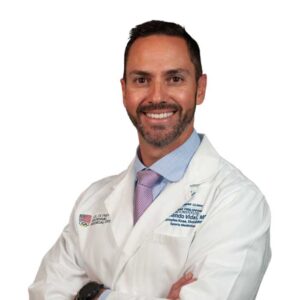What is the anatomy of a meniscus?
Each knee has two menisci which are wedge-shaped fibrocartilage discs that act as shock absorbers. The peripheral third of each meniscus has a blood supply which facilitates healing and influences our decision on whether to repair or resect the torn portion. The inner portion is thinner and tears in this portion of the meniscus often require surgical resection because it cannot be sutured. Dr. Armando Vidal, orthopedic knee surgeon, serving patients in Vail, Aspen and the surrounding Denver, Colorado communities specializes in helping patients with meniscal injuries and knee pain.

What is a partial Meniscectomy?
Over 750,000 partial meniscectomies are done each year, making it the most common outpatient surgery performed in the United States. During a partial meniscectomy, Dr. Vidal will remove as little of the meniscus as possible and will try to repair any viable parts of the meniscus, rather than remove it. In this specialized arthroscopic procedure, Dr. Vidal will trim down any frayed ends or rough surfaces that could catch in the knee joint and cause further pain. The goal is to try to preserve and sculpt as much of the remaining meniscus to try and leave as much shock-absorbing capacity as possible.
What is a total meniscectomy?
A total meniscectomy is the complete removal of the meniscus. Total meniscectomies are reserved for meniscus tears that are irreparable and have too much damage to heal properly. Dr. Vidal will make every attempt to spare as much of the meniscus as possible and will try not to do a total meniscectomy unless warranted. Patients should note there is a direct correlation between the amount of meniscus tissue that is surgically removed and the load distribution across the knee. The more tissue that is removed, the less able the knee is to sustain the load of walking, running, or other activities. With uneven load distribution, degeneration of the knee joint may happen at a faster pace than it would with an intact meniscus. For this reason, patients undergoing a total meniscectomy should be prepared to commit to a lengthy recovery process including physical therapy and strengthening exercises to delay degeneration and osteoarthritis. Dr. Vidal will make a joint decision with the patient for the best surgical outcome based on the patient’s age, activity level and the size, shape and area of the meniscus tear.
What is the recovery time following a partial meniscectomy?
This out-patient surgery typically has a quick recovery time, however patients in Vail, Aspen and the surrounding Denver Colorado communities should still be closely monitored by Dr. Vidal. Education is required to make sure patients know what causes damage to their knee and ways to avoid early osteoarthritis. Since the menisci play a vital role in the patient’s gait, joint health and overall function of the knee joint, it is important to follow Dr. Vidal’s physical therapy instructions.
Complex Knee Surgeon
Damage to the meniscus is relatively common. Oftentimes, surgery can be intimidating or extensive, which may not be a suitable option for every patient. For some patients, a partial menisectomy may be a good alternative. This surgical treatment is an outpatient operation with a quick recovery. Complex knee surgeon, Doctor Armando Vidal can help patients in Vail, Aspen, and the surrounding Denver, Colorado communities decide if a partial menisectomy is right for them. Contact Dr. Vidal’s team today!

Locations
180 S Frontage Rd W
Vail, CO 81657
226 Lusher Court
Ste 101
Frisco, CO 80443
322 Beard Creek Road
Edwards, CO 81632


